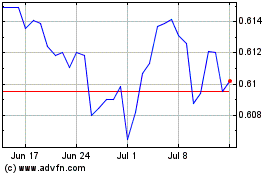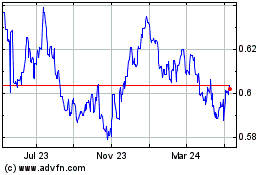Antipodean currencies such as the Australian and the New Zealand
dollars strengthened against their major counterparts in the Asian
session on Thursday, after data showed that China's exports
rebounded at a faster than expected pace, while growth in imports
slowed in March.
Data from the General Administration of Customs showed that the
China's exports, in dollar terms, grew 16.4 percent year-on-year in
March, reversing February's 1.3 percent decline. Shipments were
expected to rise 3.4 percent.
At the same time, imports advanced 20.3 percent after expanding
38.1 percent in February. Economists had forecast a 15.5 percent
increase.
As a result, the trade surplus totaled $23.9 billion in March,
smaller the expected surplus of $12.5 billion.
Exports grew 22.3 percent and imports climbed 26.3 percent in
yuan terms in March. In the first quarter, exports increased 14.8
percent and imports surged 31.1 percent.
Ahead of the data, the Australian dollar rose against its major
rivals after data showed that the number of employment in
Australian rose more-then-expected in March.
Data from the Australian Bureau of Statistics showed that the
Australian economy added 60,900 jobs in March to 12,059,600,
shattering expectations for a gain of 20,000 following the loss of
6,400 jobs in the previous month.
Full-time employment increased 74,500 to 8,238,600 and part-time
employment decreased 13,600 to 3,821,000.
The unemployment rate in Australia was steady at a seasonally
adjusted 5.9 percent in March. That was in line with estimates and
unchanged from the February reading.
Also, the NZ dollar rose against its most major rivals earlier,
after data showed that manufacturing sector in New Zealand picked
up steam in March.
Data from Business NZ showed that the manufacturing sector in
New Zealand picked up steam in March, with a Performance of
Manufacturing Index score of 57.8. That's up sharply from 55.7 in
February. The March reading also marks a 14-month high for the
index.
In other economic news, data from Statistics New Zealand showed
that food prices in New Zealand dipped 0.3 percent on month in
March. That follows the 0.2 percent increase in February.
Wednesday, the Australian dollar showed mixed trading against
its major rivals. While the aussie rose against the U.S. dollar, it
fell against the yen. Against the euro, the aussie held steady.
The NZ dollar fell 0.15 percent against the U.S. dollar, 0.41
percent against the yen and 0.24 percent against the euro.
In the Asian trading, the Australian dollar rose to a 2-day high
of 82.56 against the yen, from yesterday's closing value of 81.97.
The aussie may test resistance near the 85.00 region.
Against the euro and the U.S. dollar, the aussie advanced to
8-day highs of 1.4068 and 0.7585 from yesterday's closing quotes of
1.4170 and 0.7521, respectively. If the aussie extends its uptrend,
it is likely to find resistance around 1.39 against the euro and
0.76 against the greenback.
Against the New Zealand and the Canadian dollars, the aussie
climbed to a 1-week high of 1.0838 and a 3-day high of 1.0035 from
yesterday's closing quotes of 1.0795 and 0.9958, respectively. On
the upside, 1.10 against the kiwi and 1.01 against the loonie are
seen as the next resistance levels for the aussie.
The NZ dollar rose to a 9-day high of 0.7003 against the U.S.
dollar and a 2-day high of 1.5224 against the euro, from
yesterday's closing quotes of 0.6968 and 1.5305, respectively. If
the kiwi extends its uptrend, it is likely to find resistance
around 0.71 against the greenback and 1.51 against the euro.
Against the yen, the kiwi advanced to 76.23 from yesterday's
closing value of 75.91. The kiwi may test resistance near the 78.00
region.
Looking ahead, Swiss PPI for March and Bank of England's credit
conditions survey data are due to be released later in the day.
In the New York session, Canada new housing price index and
manufacturing sales data, for February, U.S. PPI for March, U.S.
weekly jobless claims for the week ended April 8, U.S. University
of Michigan's preliminary consumer sentiment index for April and
U.S. Baker Hughes rig count data are slated for release.
At 10:00 am ET, Bank of Canada Governor Stephen Poloz is
expected to testify along with Senior Deputy Governor Carolyn
Wilkins before the Standing Senate Committee on Banking, Trade and
Commerce, in Ottawa.
NZD vs US Dollar (FX:NZDUSD)
Forex Chart
From Mar 2024 to Apr 2024

NZD vs US Dollar (FX:NZDUSD)
Forex Chart
From Apr 2023 to Apr 2024
